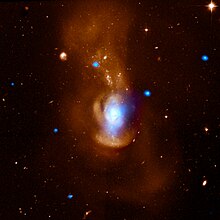NGC 4194
| NGC 4194 | |
|---|---|
′[6] | |
| Notable features | Interacting, starburst |
| Other designations | |
| Medusa galaxy merger, NGC 4194, Arp 160, UGC 7241, Mrk 201, PGC 39068[7] | |
NGC 4194, the Medusa merger, is a galaxy merger in the constellation Ursa Major about 128 million light-years (39.1 Mpc) away.[4] It was discovered on April 2, 1791 by German-British astronomer William Herschel.[8] Due to its disturbed appearance, it is object 160 in Halton Arp's 1966 Atlas of Peculiar Galaxies.[7]

The morphological classification of NGC 4194 is Imeger,[2] indicating an irregular form. This galaxy consists of a brighter central region spanning an angular size 9″ across, with an accompanying system of loops and arcs. Additional material is thinly spread out to a radius of 75″ from the central region.[9] There is a tidal tail and regions undergoing high levels of star formation, making this a starburst galaxy. It is a source for strong infrared and radio emission.[10][11] These features indicate NGC 4194 is a late-stage galaxy merger.[12] A region of extreme star formation 500 ly (150 pc) across exists in the center of the Eye of Medusa, the central gas-rich region.[13]
Within 1.2 kpc (3.9 kly) of the dynamic center of NGC 4194, star formation is occurring at a rate of 8 M☉·yr−1. The star forming regions in this volume range from 5 to 9 million years in age, with the youngest occurring in areas of the highest star formation rate.[14] As of 2014, no galactic nucleus has been detected based on radio emissions, nor have the respective nuclei of the merger galaxies.[15] However, X-ray emission from a black hole in the tidal tail was detected by Chandra in 2009.[16]
References
- ^ .
- ^ S2CID 119253507.
- S2CID 14298026.
- ^ S2CID 174801441. A38.
- ^ .
- ^ "Results for NGC 4194". NASA/IPAC Extragalactic Database. Jet Propulsion Laboratory, California Institute of Technology, under contract with the National Aeronautics and Space Administration. January 12, 2007. Retrieved 2024-03-24.
- ^ a b "NGC 4194". SIMBAD. Centre de données astronomiques de Strasbourg. Retrieved 2024-03-24.
- ^ Seligman, Courtney. "NGC Objects: NGC 4150 - 4199". Celestial Atlas. Retrieved 2024-04-01.
- doi:10.1086/149967.
- doi:10.1086/382092.
- doi:10.1086/497969.
- .
- ^ "Unknown extreme star formation discovered". Space Daily. 17 June 2015. Retrieved 2024-03-24.
- .
- .
- ^ "NGC 4194: A Black Hole in Medusa's Hair". Chandra Photo Album. March 11, 2009. Retrieved 2024-04-01.
Further reading
- König, S.; et al. (July 2018). "Major impact from a minor merger. The extraordinary hot molecular gas flow in the Eye of the NGC 4194 Medusa galaxy". Astronomy & Astrophysics. 615. id. A122. doi:10.1051/0004-6361/201732436.)
{{cite journal}}: CS1 maint: multiple names: authors list (link - Aalto, S.; et al. (November 2010). "13CO 1-0 imaging of the Medusa merger, NGC 4194. Large scale variations in molecular cloud properties". Astronomy and Astrophysics. 522. id.A59. .
- Kaaret, Philip; Alonso-Herrero, Almudena (August 2008). "X-Ray Sources in the Star-Forming Galaxies NGC 4194 and NGC 7541". The Astrophysical Journal. 682 (2): 1020–1028. doi:10.1086/589764.
External links
- NGC 4194 on
